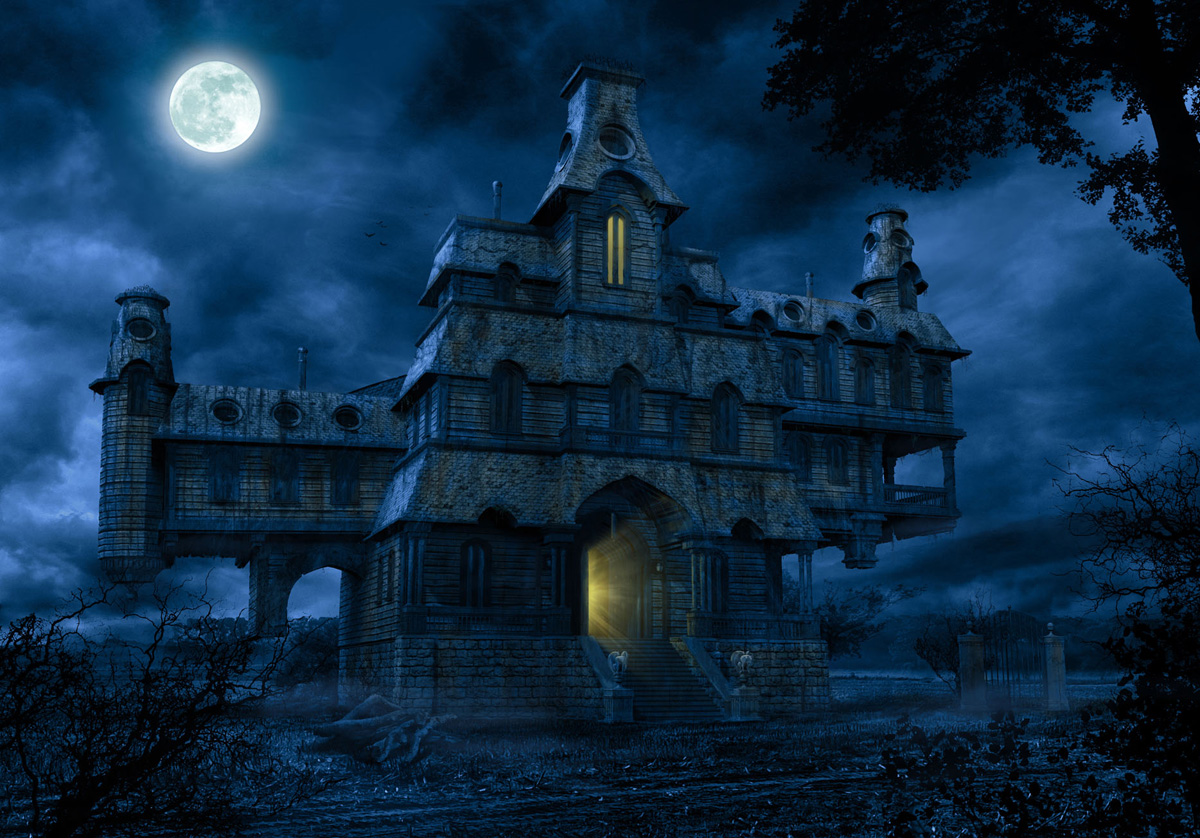 Submitted by Morgana on
Submitted by Morgana on

A good study by Sarah Greenway -
Imagine you’re sitting alone in front of a roaring log fire; the flames are dancing up the chimney and vigorously rosying your cheeks, whilst outside, the wind howls through the trees, and the driving rain taps its icy fingers on the windowpane.
You pull your dressing gown around you, and glance out at the impenetrable blackness that engulfs the house. Save for the full moon riding high in the night sky, there is no light. Not even a pinprick. The bookshelves that surround you are full of dusty antique tomes, and the stern faces of long departed ancestors stare down disapprovingly from the walls. Somewhere in the darkened hall, just beyond the door that stands ever so slightly ajar, a grandfather clock marks time with its heavy heartbeat, tick-tock, tick-tock, tick-tock. It’s the only sound in an otherwise silent house. The only sound that is… until you hear the knocking.
And now imagine that you were told before you arrived there, that the house was haunted. Imagine that you were told that the ghost of the previous owner, (an old man,) walks along the long corridors in the middle of the night, (particularly stormy nights,) and knocks at each door until someone answers. Would you be inclined to disregard the sound of knocking as merely the settling of an old house or would you immediately leap to the conclusion that the spirit of the old man was hovering just outside the door, waiting to pounce as soon as you open it?
To examine the ‘Psychology of hauntings,’ it’s important to first look at the many different factors that can manipulate us when faced with a potential paranormal event. These psychological components, all contribute to altering our evaluation and can interfere quite significantly with our ability to make a rational unbiased judgement.
It’s no accident, (or delusion of literary grandeur!) for instance, that I used quite such dramatic and descriptive language in my little scenario. Words can create a picture in your mind and plant suggestions extremely effectively; words like ‘tomes’ (instead of books) for example, which is a very similar word to tombs, thereby evoking the idea of death. The idea of being all alone at night time is also quite a frightening image for some people, and produces a more heightened sense of expectation even before you introduce any other factors.
If I were now to place you in that old house, with the storm raging outside and leave you there alone in the dark, the suggestions I’ve planted would be highly likely to colour your perception of whatever you were to experience. If a floorboard creaks or a door bangs in a building that we’ve been told is haunted, we are in danger of instantly attributing it to ‘the ghost,’ and consequently, in the field of paranormal research, suggestion and perception are closely linked.
More often than not, we see what we’ve been told we’ll see, or what we expect to see, given our emotional and psychological state at the time. During Lincs PRT investigations, we’re very careful not to suggest things to one another, instead preferring to record our views and experiences separately, both during and after the investigation. We can then review the information gathered, and if there’s a strong similarity between two or more of the reports, we can examine that further as un-influenced evidence.
If we’re in a heightened emotional state, be it that of fear, anger, depression or happiness for example, we can be all too ready to leap to unsubstantiated conclusions. It’s all too common for someone to believe they’ve experienced something paranormal when under stress and/or feeling one or more of the above emotions.
The paranormal investigator is also at the mercy of any prior knowledge gained about a research location. Very often, if you’ve investigated a site before or read the reports of others who’ve been there, you’re more likely to expect those same things to happen again, even if only on a sub-conscious level. Of course, if a medium accompanies the group on an investigation, it’s both in their interests and the interests of the research team that they know nothing of the location and nothing of the previous findings of any other groups who’ve attended. If true proof is ever to be found supporting or disproving the abilities of mediums, any information they offer must be able to be corroborated by historical fact or direct eye witness testimony, and preferably not details that can be found in any widely available text book or website. Only then can we begin to confirm that there is an after life and that communication between the two dimensions is possible.
As we’ve already mentioned, atmospheric conditions also add to our expectation of a situation. A warm sunny summer’s evening is less likely to provoke fear and anticipation than a stormy winter’s night. Similarly, factors such as solar flares and the phases of the moon can be said to affect our perceptions and reactions to events. Radiation from solar flares can affect the instruments we use during investigations, and in some cases, can affect people too – although it’s quite a negligible amount of radiation that finally reaches Earth because our magnetic field repels most of the solar wind.
As the National Weather Service’s Space Environment Centre website says, “Occasionally solar flares, prominences, and coronal holes (holes in the sun's atmosphere) send high levels of electromagnetic radiation toward the Earth in the form of X-rays… Solar activity can garble radio transmissions, fry the electronics on satellites and in antennas. The power industry has problems with solar events as well, as their transformers can be overloaded. Almost any industry that uses electronics in space can be affected by extremely powerful bursts, but these are rare.”
Paranormal activity is often said to be most prevalent around the time of a new or full moon. As we have known for centuries, the moon governs our tides and the currents of our rivers due to the gravitational force it exerts on our planet. When you remember that most of the human body consists of liquid, it takes no stretch of the imagination to see that we are also directly affected by the phases of the moon. Women are particularly influenced, due to the fact that the menstrual cycle is simply an internal ‘tide,’ again determined by the activity of the moon and its waxing and waning phases.
Arnold Lieber, (a psychologist,) and his colleagues at the University of Miami, decided to test the old theory that people go mad, (or to put it another way, ‘loony’ – derived from ‘lunar’) at the time of a full moon. They collected statistics on 1,887 murders in Dade County (Miami) over a period of 15 years, and when they matched the numbers of homicide with the phases of the moon, they found that the two rose and fell together, almost unfailingly, for the entire 15 years. As the full or the new moon advanced, the murder rate rose abruptly, and then it noticeably declined during the first and last quarters of the moon.
To ascertain whether this was merely a fluke, they repeated the experiment using data from Cuyahoga County in Ohio (Cleveland). Again, the figures showed that more murders definitely occur at the full and new moons.
So would it be fair perhaps to theorise that hauntings (not necessarily the work of spirits but more the sightings of ghosts) would be more prevalent around the time of a new or full moon? Using the murder study findings, we could logically assume that if the full/new moon affects the levels of emotion in humans making them more prone to violent or erratic behaviour, then the energies that fuel paranormal activity could indeed also be heightened at this time, giving greater force to the recorded emotions stored in locations where death or tragedy has occurred – often the places where ghosts sightings are most frequently reported. It’s a theory worth investigation in itself, and one that we have attempted to explore ourselves, often trying to arrange our investigations at these phases of the moon. So far we haven’t found any conclusive evidence to prove this theory, but we’ll keep noting our findings on the site.
So we can see that suggestion, atmospheric conditions, prior knowledge and both solar and lunar activities can have a tremendous influence on our perceptions. However probably the most potent psychological ingredient in colouring our assessment of a situation is belief. Whether we believe whole-heartedly in an after-life, and subscribe to a particular religion, or whether we are completely sceptical of paranormal explanations for events and an atheist to boot, both are beliefs. Whatever we hold true, whatever we put our faith in, be it religion or science, will cause our judgement to alter accordingly, no matter what evidence to the contrary is presented to us in some cases.
The world of paranormal investigation attracts people from both camps. It also attracts those who fall into the ‘middle of the road’ group, and it’s these open-minded individuals that we all hope to emulate when investigating or assessing any potential paranormal activity. The ability to remain open to all possibilities, without influence by suggestion, atmospheric conditions, prior knowledge or belief is optimum and will mean the difference between gaining real and substantiated evidence or merely a subjective view point, that cannot stand up to examination.
- 1891 reads